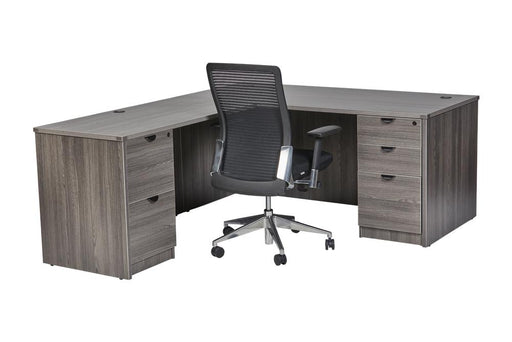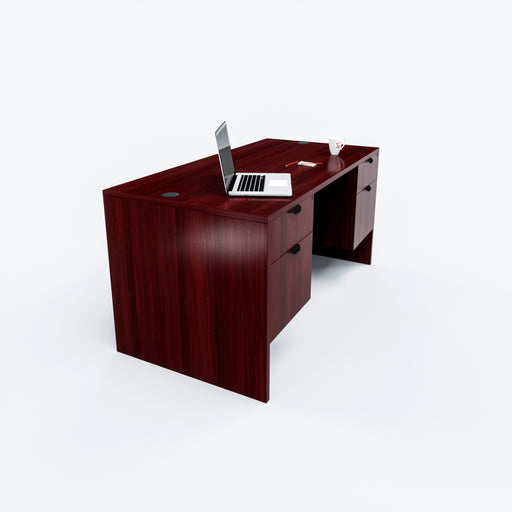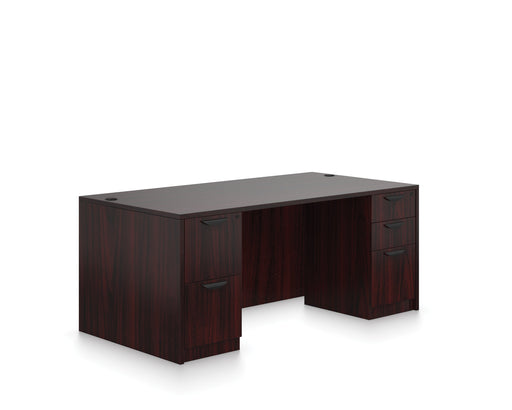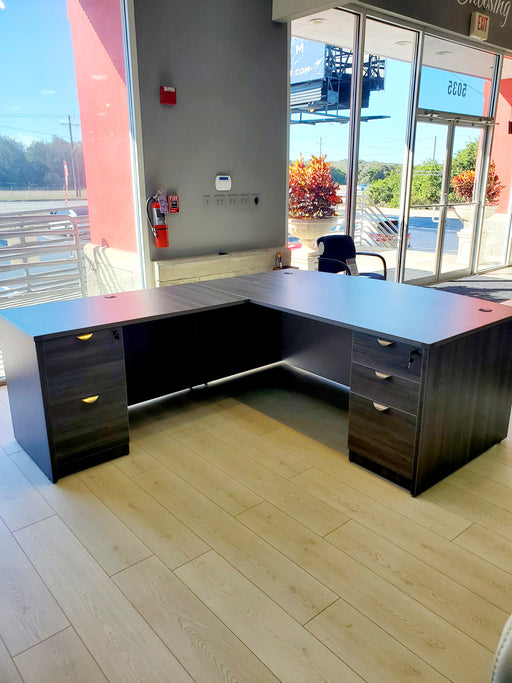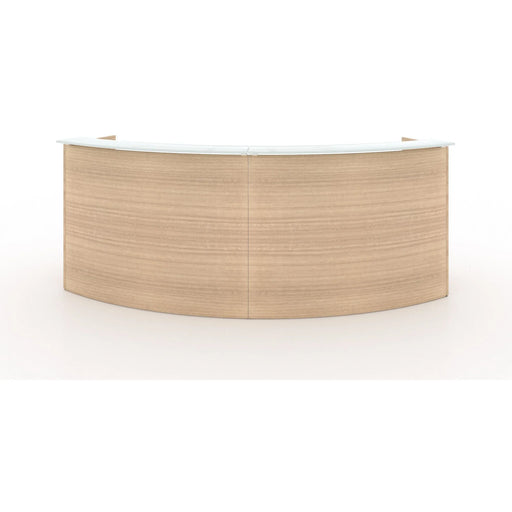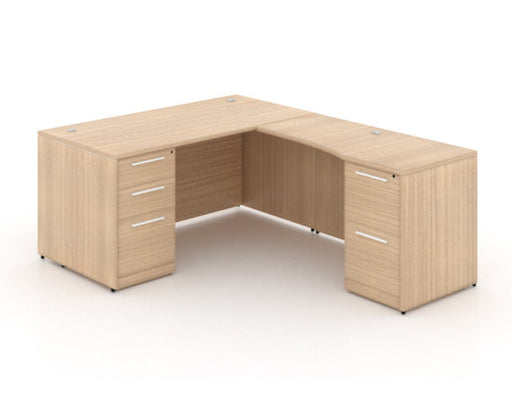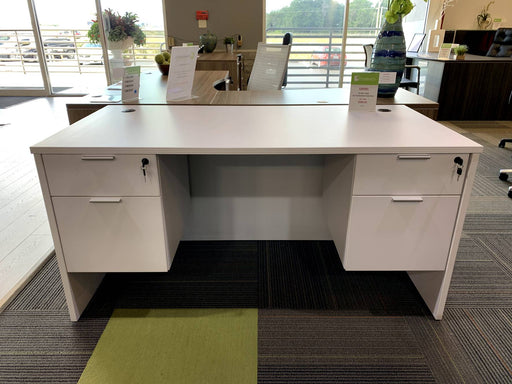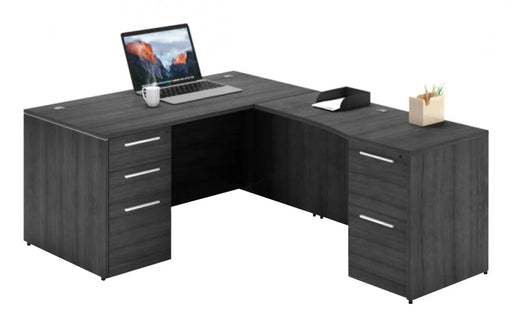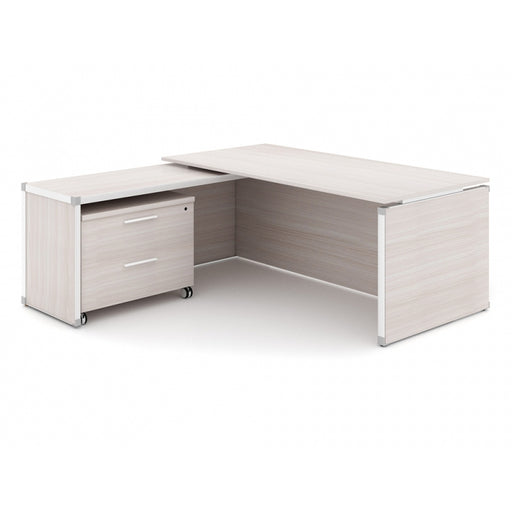-
-
- Satellite Offices
- Boca Raton
- Miami
- Jacksonville
- Naples
- Sarasota
- Fort Myers
- Gainesville
- Ocala
- Daytona Beach
- Tallahassee
- Hollywood
- All Locations

Standing Desk Ergonomics: The Ultimate Guide
When it comes to the ideal workstation setup, everyone's needs are different. You might prefer to work on the sofa, at a desk, or at a standing desk. Standing desks have many benefits for focus and posture—but only if you choose a suitable desk and use proper standing desk posture.
So, what must you consider before buying your first standing desk?
Keep reading as we’ll explore the ins and outs of standing desk ergonomics and how to choose your perfect desk. At Freedman's Office Furniture, we provide quality and elegant office furniture suited to any needs—check out our desk collection now!
Why Is It Important To Use A Standing Desk Correctly?
A standing desk can do wonders for your body, mind, and health. However, misusing a standing desk will not provide you with the benefits of standing while you work. Below is a list of some of the reasons why you should use a standing desk and, more importantly, use it correctly.

Improves Posture And Reduces Back Pain
When sitting for long periods, we are not exercising the supportive muscles at the base of our spine. The back is entirely supported in a comfortable chair, so you do not need to engage those important back muscles that are responsible for maintaining good posture and preventing back pain.
Increases Energy And Focus
While working, your primary concern is maintaining a solid level of focus without becoming uncomfortable in your chair or too relaxed and sluggish. A standing or sit-stand desk allows you to work while engaging the body's muscles, so you will stay energized and focused throughout your work day. And, when you stand up, you can avoid the discomfort in your backside caused by long hours of sitting.
Reduces The Risk Of Chronic Diseases
Even if you alternate between sitting and standing throughout the day, you can reduce your risk of chronic diseases with extra exercise. Working in an office or a sedentary position throughout the day can increase your chances of developing chronic diseases caused by inactivity and weight gain.
Improves Circulation And Reduces The Risk Of Blood Clots
When you sit down, this places a compression in your pelvic and thigh region, restricting circulation. Sitting for a long time is not recommended if you have a disorder that increases your chance of developing blood clots. Instead, you can opt for a standing desk to keep your circulation moving fluidly and reduce your risk of developing a blood clot.
Increases Productivity And Creativity
If you are sitting at your desk, mulling over the same information, this can cause you to feel stuck in a rut. By switching things up and standing at your desk, you can refresh your mindset and increase your feelings of productivity and creativity. Office design and furniture are crucial to optimize productivity levels.
Reduces The Risk Of Eye Strain And Headaches
Text neck strain is a term used to describe necks that look down too much, causing tension and discomfort. Text neck can lead to eye strain, headaches, and other health problems, like musculoskeletal disorders. Standing at your desk ensures an upright position, reducing your risk of neck pain.
Helps You Maintain A Healthy Weight
If you're looking for the best way to maintain your weight or lose weight with minor lifestyle changes, a standing desk might just be the answer. Even with a rigorous exercise routine, some people find it extremely difficult to lose weight as they spend extended periods sitting down and not burning any calories. A standing desk helps you maximize your weight loss regime and drop weight even while working.
Common Mistakes When Using A Standing Desk
A standing desk isn't as straightforward as it seems, you know? There are some best practices you can utilize, and some mistakes to avoid, to get the most out of your standing desk.
Standing Too Long
Although we shouldn't sit for too long, we also shouldn't stand too much, either. Standing for too long can make you feel tired, impatient, and bored at work. Also, with your feet flat on the floor all day, you might experience soreness in your ankles and the soles of your feet.
Improper Posture
Simply buying a standing desk will not fix your posture on its own. To prevent pain, you must maintain a correct posture and position your desk at the right height.
Wearing The Wrong Shoes
High heels are a definite no if you are at your desk all day. Sandals, flip-flops, and other unsupportive shoes are not an option either. You need supportive shoes with the proper padding to stop your feet from being flat on the floor.
Placing The Monitor Too Low
If you raise your desk but your monitor is still too low, you won't get the benefits of standing. To ensure your neck is in the proper standing desk posture, place the monitor arms on a stand, book, or box to adjust the height and ensure it is at eye level.
Flexing The Wrists
It’s best to keep your wrists straight when working at a standing desk, to avoid strain and trapped nerves. Keeping your wrists bent can lead to musculoskeletal disorders relating to the hands.
Failing To Adjust The Desk Height
When working at a sit-stand desk, adjusting the desk height is essential to ensure you are not reaching or crouching to view your computer, write, or type.
Standing Still
Standing Still is boring and not what this desk was designed for! Move around as much as you please to create more space in the spinal column and stretch out those muscles.
Proper Ergonomics For Someone Standing In The Workplace
Now you know what not to do, let's discuss what you should do for proper standing desk ergonomics.

Elbows Should Be Relaxed And Close To The Body, Bent At A 90 Degree Angle
There is no need to place extra strain on your arms when using a standing desk. Position yourself so your elbows are relaxed by your sides, and bend them at a 90-degree angle to reach your desk.
Wrists Should Be Straight And Hands Should Be At Or Below Elbow Level
You don't just need to worry about your arm position. Your hands should also be horizontal to your elbows and never above elbow height. This way, you can keep your wrist straight for a more comfortable standing position, avoiding carpal tunnel syndrome.
The Monitor Should Be Placed At Eye Level And Be An Arm's Length Away
A height-adjustable desk is only helpful if you place your monitor arms at the correct height. To properly support your eyes and posture, put the computer screen at eye level and within arm's reach away from you. This way, you won't strain your eyes to see clearly or strain your neck by looking up or down.
Shoulders Should Be Relaxed And Not Elevated Or Hunched Forward
If you're working at a standing desk, keep your upper arms in the proper position next to your ribcage. This way, your shoulders won't slump forward, resulting in bad posture and potential injury and strain.
The Head Should Be In A Neutral Position, Not Tilted Up Or Down
If your head is tilted, whether up or down, this will cause some unnecessary strain. The head should be facing forwards at all times for optimal neck posture. If it is only slightly bent, this should be fine.
Use A Keyboard With A Negative Tilt To Increase Wrist And Forearm Support
Negative tilt is your best friend regarding wrist position in an ergonomic workspace for standing benefits. The keyboard height ensures your hands and wrists are flat in your standing posture.
Prop One Leg Up On A Footrest To Reduce Lower Back Pain
You can get creative with how you stand at a standing desk. Poor posture can lead to pain, but so can a stagnant position. You can prop up your foot to rest your leg muscles and keep your knees slightly bent to reduce strain on your knee joints.
Wear Comfortable Shoes With Good Arch Support
Flat feet are pained feet. You should wear shoes with proper arch support or get inserts to ensure your feet aren't flat on the floor, which can increase discomfort.
Invest In A Standing Desk Mat To Reduce Fatigue And Increase Support
A contoured standing mat can help you reduce flat foot posture and ensure padded support for your standing position. Hard and solid floors are your feet's worst enemy.
Consider Using A Leaning Stool
A leaning stool is the best way to have a slightly rested upright standing position. You can perch your rear on the stool while supporting your weight with your feet, ultimately reducing the pressure on your pelvis.
FAQs
Below are some questions you may still have regarding standing desks and how to use them!
What Is The Proper Way To Use A Standing Desk?
To use your standing desk, you must adjust desk height and computer monitor height separately to ensure a proper upright position. You'll also need to ensure your wrist position is correct and wear comfortable and supportive shoes.
At What Height Should You Set Your Computer While Using A Standing Desk?
The perfect height for your computer is at eye level. This way, you won't have to look up or down, which can cause annoying strains and pains in the neck region. You should also ensure your computer is at arm's length from your face, preventing you from straining your eyes to see.
How Long Should You Stand For While Using A Standing Desk?
You should only stand for three hours before resting to sit and enjoy a coffee—it's not great to keep the body in any position for too long, whether sitting or standing!
How Can You Maintain Proper Posture While Standing At A Desk?
To maintain proper posture while standing at a desk, keep your shoulders and elbows relaxed by your sides. This way, you can avoid hunching, which is the leading cause of poor posture in the upper body.
How Can You Prevent Body Pains While Standing At A Desk?
Take plenty of breaks! And be sure to move around a lot while you're working. The movement and freedom is the best part of using a standing desk, no?
What Desk Stretches Can You Do To Prevent Pain And Stiffness?
The best desk stretches to prevent pain and stiffness involve moving your arms in circles to alleviate shoulder pain, circling your neck to reduce stiffness, rotating your hips, and performing lunges.
How Can You Customize Your Active Workstation For Maximum Comfort?
Anti-fatigue mats can help you support your legs and feet for optimal comfort. Standing on a stiff or hard floor for ages will leave your feet sore and unhappy!
Are Standing Desks Worth The Investment?
Standing desks are worth the investment to improve posture and back strength and support weight loss. A standing desk can also help reduce your risk of developing clots if you have a health condition relating to blood clots.
Conclusions
Buying a standing desk involves knowing how to stand with great posture, position your desk, and take full advantage of ergonomic features. Opting for a sit-stand or standing desk can help you get some standing time throughout the day and improve your general well-being with a neutral spine posture.
At Freedman's Office Furniture, we offer all the tools you need to create a comfortable working environment, supporting the human body through the workday. Browse our collection of desks now to find the perfect office solution!























